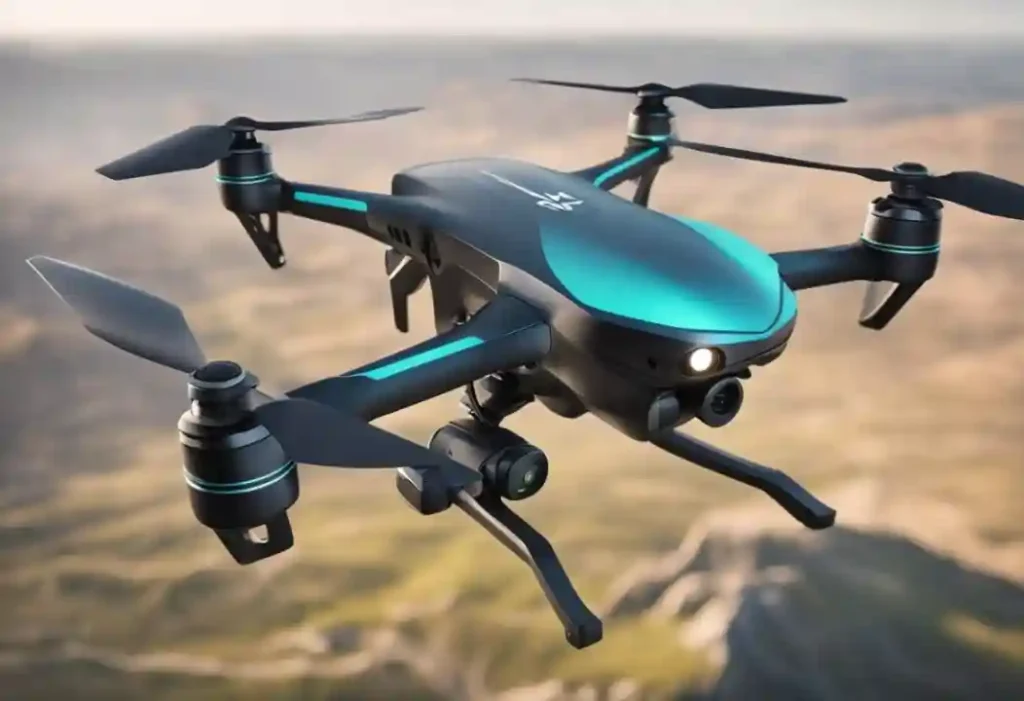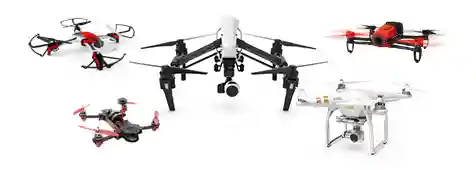FPV drones change how we fly. These machines let you see from the sky. You feel like you are flying in the air.
Many people love FPV drones now. They give amazing views. Flying becomes more fun and exciting.
What Are FPV Drones?

FPV means First-Person View. These drones have cameras on them. The camera shows you what the drone sees.
You wear special goggles to see the video. It feels like you sit in the drone. This makes flying very different from normal drones.
Regular drones stay far away when you fly them. FPV drones let you see up close. You can fly through trees and buildings safely.
Parts of FPV Drones
Every FPV drone needs these parts:
- Camera – Takes video while flying
- Video sender – Sends pictures to your goggles
- Goggles – Show you what the drone sees
- Remote control – Makes the drone move
- Flight board – Keeps the drone stable
- Motors – Spin the propellers
- Propellers – Lift the drone up
- Battery – Powers everything
- Frame – Holds all parts together
All these parts work together. They make flying possible.
Different Types of FPV Drones

FPV drones come in many styles. Each type does different jobs. Pick the right one for what you want to do.
Racing Drones
Racing drones go very fast. They can fly over 100 miles per hour. People race them in competitions.
- Very light weight – Usually under 500 grams
- Super fast – Reach amazing speeds quickly
- Strong frame – Can crash without breaking
- Quick response – Turn and move instantly
- Low delay – Video shows up right away
These drones win races. Speed matters most here.
Trick Flying Drones
Freestyle drones do cool tricks in the air. They flip and roll smoothly. Many people use them to make videos.
- Good balance – Mix of speed and control
- Smooth flying – Perfect for filming
- Medium weight – Usually 400-700 grams
- Camera ready – Can carry action cameras
- Longer flights – Fly for 5-8 minutes per battery
These drones look great on video. They make amazing footage.
Movie Making Drones
Cinema drones make professional videos. They have the best cameras. Movies and TV shows use these drones.
- Steady cameras – No shaky footage
- Long flights – Fly for 15-30 minutes
- High quality video – Record in 4K or better
- Auto flying – Follow people by themselves
- Safety sensors – Avoid hitting things
Big productions use these drones. They cost more but work better.
Small Indoor Drones
Tiny drones fly inside houses. They are safe and easy to learn on. Kids and beginners love them.
- Very small – Weigh less than 250 grams
- Safe indoors – Soft propellers won’t hurt
- Easy to fly – Good for learning
- Cheap – Cost less money
- Short range – Stay close to you
Start with these if you are new to FPV flying.
Why FPV Drones Are Great
FPV drones do things other drones cannot. They give you special abilities. Flying becomes much more fun.
Feel Like You Are Flying
The goggles make you feel like a bird. You see everything the drone sees. This feeling never gets old.
- See everything – Watch the world from above
- Know where you are – Never get lost
- More exciting – Heart pumping fun
- Fly precisely – Get exactly where you want
- Easy on eyes – No looking up at tiny dots
This feeling makes people love FPV flying.
Better Control
FPV gives you perfect control. You can fly in tight spaces. Landing becomes easy and accurate.
- Fly through gaps – Navigate small openings
- See dangers – Spot problems before crashes
- Land perfectly – Put the drone exactly where you want
- Stay safe – Avoid hitting things
- Go farther – Fly beyond what your eyes can see
Control improves when you see what the drone sees.
Make Amazing Videos
FPV drones create incredible footage. No other camera can move like this. Your videos will look professional.
- Smooth movements – Flowing camera work
- Unique angles – Shots nobody else can get
- Get close safely – Fly near people and objects
- Film indoors – Work in tight spaces
- Follow action – Track moving subjects perfectly
Content creators choose FPV for the best results.
Learn New Skills
Flying FPV teaches valuable abilities. Your coordination gets better. Problem solving improves too.
- Hand control – Better coordination develops
- Space thinking – Understand 3D movement
- Quick reactions – Respond faster to changes
- Fix problems – Handle unexpected situations
- Technical knowledge – Learn about electronics
These skills help in other parts of life.
Best FPV Drones for 2025
Here are the top FPV drones you can buy now. Each one fits different needs and budgets.
DJI Avata 2
This drone works great indoors. It has guards around the propellers. Beginners love how safe it is.
- Small size – Fits through doorways easily
- Light weight – Only 377 grams total
- Built-in guards – Protects propellers from walls
- Good camera – Takes nice videos
- Easy to use – Simple for new pilots
- Tough build – Survives crashes well
The Avata 2 gives the best indoor flying experience.
BetaFPV Cetus X
This complete kit has everything you need. Perfect for people just starting out. The price stays reasonable.
- Complete set – Includes drone, goggles, and controller
- Beginner friendly – Made for new pilots
- Safety modes – Different skill levels available
- Good value – Fair price for everything included
- Indoor safe – Won’t damage furniture
- Crash resistant – Handles learning accidents
Buy this if you want to start FPV flying today.
iFlight Racing Drones
iFlight makes many different models. They have options for every flying style. Quality stays high across all models.
- Racing models – Super fast competition drones
- Freestyle versions – Balanced performance for tricks
- Quality parts – Reliable components throughout
- Many choices – Different sizes and power levels
- Good support – Helpful community and guides
- Fair prices – Good value for the money
iFlight gives you many choices for any flying style.
Build Your Own Drone
Advanced pilots often build custom drones. You pick every part yourself. This gives perfect customization.
- Choose everything – Select exactly what you want
- Best performance – Tune for your flying style
- Save money – Often costs less than pre-built
- Learn more – Understand how everything works
- Easy repairs – Fix what breaks yourself
- Upgrade anytime – Change parts when needed
Building teaches you the most about drones.
Equipment You Need for FPV
Flying FPV needs more than just the drone. These accessories make the experience complete and safe.
FPV Goggles
Good goggles show clear video with no delay. Comfort matters for long flying sessions.
- Clear picture – Look for 1080p or better
- No delay – Video shows instantly
- Comfortable fit – Important for longer flights
- Eye adjustment – Fits different eye spacing
- Record flights – Save your flying videos
- Multiple signals – Work with different systems
Goggles make or break your FPV experience.
Radio Controllers
Quality controllers give precise drone control. Range and reliability matter most.
- Many channels – Control different functions
- Long range – Stay connected far away
- Comfortable grip – Good for long flying
- Custom buttons – Set up how you like
- Long battery – Lasts many flights
- Flight info – Shows important data
Good controllers make flying more enjoyable.
Batteries and Chargers
Batteries power your drone. You need several for good flying sessions. Safety comes first.
- Right size – Match your drone’s needs
- Quality brands – Stick to known makers
- Safe storage – Keep at proper charge levels
- Good chargers – Invest in safety features
- Multiple batteries – Have spares ready
- Voltage checker – Monitor battery health
Battery safety prevents fires and accidents.
Safety Gear
Safety equipment protects you and others. Never skip these important items.
- Safety spotter – Someone to watch for aircraft
- First aid kit – Handle minor cuts and scrapes
- Fire extinguisher – Put out battery fires
- Landing pad – Protect drone during takeoff
- Spare propellers – Replace broken ones quickly
- Basic tools – Make simple repairs
Safety gear prevents serious accidents.
Uses for FPV Drones
FPV drones work for many different jobs. Their special abilities open new possibilities.
Drone Racing
Racing has become a real sport. People compete for prizes around the world. Courses test speed and skill.
- World competitions – Big events with cash prizes
- Local clubs – Community racing groups
- Indoor tracks – Fly year-round regardless of weather
- Different classes – Categories for all skill levels
- Growing sport – More people join every year
- TV coverage – Racing appears on television now
Racing turns flying into competitive sport.
Making Movies
Hollywood uses FPV drones for action scenes. They create shots impossible with other cameras.
- Smooth movements – Flow through scenes beautifully
- Close flying – Get near actors safely
- Indoor work – Film inside buildings easily
- Chase scenes – Follow cars and people perfectly
- Unique shots – Angles no other camera achieves
- Lower cost – Cheaper than helicopters or cranes
Movies look better with FPV drone footage.
Emergency Rescue
Police and fire departments use FPV for emergencies. They can search dangerous areas safely.
- Search missions – Find missing people quickly
- Disaster check – See damage after storms
- Dangerous places – Look without risking lives
- Night work – Thermal cameras see in darkness
- Real-time info – Send live video to teams
- Save money – Cost less than helicopters
FPV drones save lives in emergencies.
Building Inspection
Companies check bridges, power lines, and buildings with drones. This keeps workers safe on the ground.
- Bridge checks – Inspect without shutting down traffic
- Power lines – Check electrical systems safely
- Roof inspection – See building tops without ladders
- Pipeline patrol – Follow long pipes efficiently
- Wind turbines – Check tall structures easily
- Cell towers – Inspect antennas and equipment
Inspections become safer and faster with drones.
Selling Houses
Real estate agents use FPV to show properties. Virtual tours help sell homes faster.
- House tours – Smooth walkthroughs inside and out
- Special angles – Show properties from above
- Neighborhood views – Display local amenities
- Large lots – Cover big properties completely
- Indoor flying – Film room-to-room tours
- Stand out – Different from regular photos
FPV footage helps houses sell quicker.
Safety Rules and Laws
Flying FPV drones safely requires following rules. Laws keep everyone protected.
Government Rules
The FAA controls drone flying in America. Their rules keep aircraft separate and safe.
- Register drones – Drones over 250 grams need registration
- Remote ID – All registered drones must broadcast location
- Height limits – Stay under 400 feet high
- Keep in sight – Maintain visual contact with drone
- Airport zones – Stay away from aircraft
- Night flying – Requires lights and special permission
Follow these rules to fly legally.
Other Country Rules
Every country has different drone laws. Research before traveling with equipment.
- Check local laws – Rules change by location
- Registration differences – Weight limits vary
- Flying permits – Some places need special permission
- Insurance rules – Coverage requirements differ
- Import limits – Some countries restrict drone imports
- Radio frequencies – Different bands allowed
Always research before flying somewhere new.
Flying Safely
Good safety habits prevent accidents and injuries.
- Check everything – Inspect equipment before flying
- Watch weather – Avoid wind and rain
- Monitor battery – Check power levels constantly
- Use spotters – Have someone watch for aircraft
- Plan emergencies – Know what to do if things fail
- Respect privacy – Don’t fly over private property
Safety habits become automatic with practice.
Common Dangers
Understanding risks helps avoid accidents.
- Spinning blades – Propellers cut skin easily
- Battery fires – Damaged batteries can ignite
- Signal loss – Losing video or control causes crashes
- Getting confused – Easy to lose direction during flight
- Other aircraft – Planes and helicopters are dangerous
- Electrical problems – Bad charging causes fires
Knowing dangers helps prevent accidents.
Learning to Fly FPV
Starting FPV flying takes patience and practice. Follow these steps for success.
Picking Your First Drone
Choose beginner-friendly equipment for the best learning experience.
- Ready-to-fly kits – Everything included in one box
- Beginner features – Stability help and safety modes
- Crash resistant – Survive learning accidents
- Local support – Community help available
- Fair price – Don’t spend too much at first
- Upgrade path – Room to grow later
The right first drone makes learning enjoyable.
Important Skills
FPV flying requires specific abilities that improve over time.
- Know direction – Always track where the drone points
- Smooth control – Gentle movements work best
- Emergency flying – Practice what to do when things fail
- Battery watching – Monitor power throughout flight
- Weather reading – Understand safe conditions
- Space awareness – Think in three dimensions
Practice these skills in safe areas first.
Learning Steps
Follow this progression to build skills safely.
- Computer practice – Use simulators before real flying
- Visual flying – Master basics without goggles first
- Indoor start – Begin in controlled spaces
- Short outdoor flights – Gradually increase distance
- Advanced moves – Learn tricks after mastering basics
- Pick specialty – Focus on racing, tricks, or filming
Patient learning builds solid skills.
Common Mistakes
Avoid these errors that slow learning progress.
- Going too fast – Trying advanced flying too soon
- Skipping safety – Not using proper safety equipment
- Poor maintenance – Neglecting equipment care
- Not enough practice – Rushing through basic skills
- Wrong equipment – Gear not matched to skill level
- Ignoring laws – Flying without knowing rules
Learning from others saves time and money.
Taking Care of FPV Drones
Regular maintenance keeps equipment working safely and reliably.
Regular Checks
Inspect equipment before every flight to catch problems early.
- Look for damage – Check for cracks or breaks
- Replace propellers – Change damaged ones immediately
- Clean motors – Remove dirt and debris
- Check connections – Look for loose or corroded wires
- Inspect frame – Find stress cracks early
- Update software – Keep flight systems current
Regular checks prevent most failures.
Battery Care
Batteries need special attention for safety and performance.
- Store properly – Keep at recommended charge levels
- Control temperature – Store in cool, dry places
- Check regularly – Look for swelling or damage
- Charge safely – Use quality chargers with proper settings
- Track usage – Monitor how many times used
- Dispose safely – Get rid of old batteries properly
Good battery care prevents dangerous fires.
Fixing Problems
Know how to handle common issues that come up.
- Video problems – Check antenna connections and position
- Control issues – Verify transmitter and receiver pairing
- Poor performance – Clean motors and check propellers
- Unstable flight – Calibrate sensors and check balance
- Range problems – Inspect antennas for damage
- Charging issues – Check settings and battery condition
Learn to fix simple problems yourself.
Getting Help
Some problems need professional repair or expertise.
- Electronic failures – Circuit board problems
- Crash damage – Major structural damage
- Performance issues – Problems beyond basic fixes
- Safety worries – Anything that might cause accidents
- Warranty work – Manufacturer defects
- Complex upgrades – Difficult modifications
Know when to ask for professional help.
Future of FPV Drones
FPV technology keeps getting better. Exciting changes are coming soon.
New Technology
Several advances will improve FPV flying in coming years.
- Better displays – 4K and 8K goggles coming
- Less delay – Almost instant video transmission
- Better batteries – Longer flights with lighter weight
- Smarter flight – Better stability and automatic features
- Smaller parts – Lighter components with more power
- Computer help – Smart systems to avoid crashes
These improvements make flying easier and more fun.
Growing Market
More people discover FPV flying every year.
- More pilots – Growing number of people flying
- Business use – Companies using drones for work
- Better integration – FPV features in regular drones
- School programs – Education including drone technology
- More racing – Competition leagues expanding
- Content creation – Filmmakers using FPV more
Growth brings better products and lower prices.
Changing Rules
Laws evolve to allow new uses while staying safe.
- Remote ID systems – Standardized identification coming
- Extended range – Beyond line-of-sight permissions
- City flying – Integration with air taxi systems
- Global standards – Same rules worldwide eventually
- Automatic systems – Rules for computer-controlled flight
- Privacy protection – Balanced rules protecting people
Rule changes enable new possibilities safely.
Conclusion
FPV drones offer amazing flying experiences. They let you see the world from the sky. Technology keeps improving rapidly. Success needs understanding safety rules and practicing regularly. FPV works for racing, filming, and business use. Whether you want competition or beautiful videos, FPV drones offer something special. Now is a great time to start flying.






